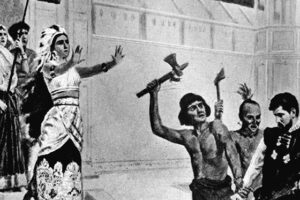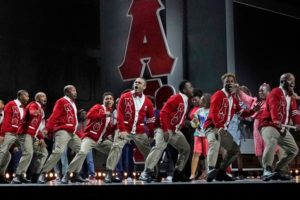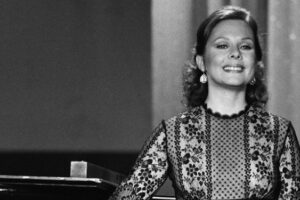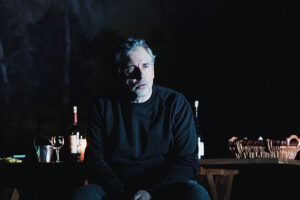

She entered looking like a vision, her lovely heart-shaped face framed in a flattering Victorian white gown, with white flowers and a veil. If she had any opening night debut nerves, she didn’t show it. She executed the tricky scales of “Son vergin vezzosa” with a sweet placidity, each note carefully in place. Her voice is attractive—bright without being shrill, fluttery without being bleaty. There’s a slight whiteness in her upper register but it’s a very pleasing sound. There’s a similar cleanness to her singing—a doll-like precision and gentle manner that loops past Callas, Sutherland, and Sills all the way back to Amelita Galli-Curci.
Her acting was well planned—at any moment, she looked like an 19th century lithograph. She gently laid her head on Arturo’s (Lawrence Brownlee) shoulder when she was in love. She sadly plucked flower petals when she was “mad”. When the going got tough, she fell to the floor, but modestly, never letting an inch of ankle show. Her wavy brown hair hair tumbled down her back, but the strands never got in her face. She even made a habit of tilting her face and eyes downward, like a very well-bred young lady of previous centuries would do.
However, as the evening wore on, her calmness and serenity became less endearing. Bel canto isn’t always about looking and sounding beautiful at all times. The aria/cabaletta structure is designed so that the music builds in momentum, and climaxes in exciting flourishes. The concertato that ended the first act is classic Bellini in that it starts with one voice, then builds with the chorus, and the melody rises and soars, and at that moment, the prima donna’s voice should ideally carry the ensemble, rising and soaring just a little more than everyone else’s voice.
Peretyatko was absolutely lovely in the more lyrical sections of the score (like “Qui la voce”) but she had a tendency to pull back the energy and the attack just when all eight cylinders should start roaring. In the act one concertato her voice got lost in the ensemble, and then she dropped out completely for several bars before returning to hit a carefully prepared high B-flat. It was only in the last act “Vieni fra queste braccia” where she, perhaps inspired by Brownlee’s brilliant vocal acrobatics, dialed up her excitement level. She’s a very lovely singer, with a lot of potential, but right now a little less than the sum of her parts.

The tenor’s leggiero voice has more ring and volume than it did in the past, and his technique is amazing. For those keeping track of these things: yes, he hit the C-sharp in “A te o cara,” yes he hit both D’s in “Vieni fra queste braccia” and he just made it to the F in “Credeasi, misera.” Finding a tenor willing to sing Arturo’s music, in the original keys, without cuts, is definitely the limiting factor in Puritani productions and I think Brownlee’s performance is as good as it gets today. Now will someone in the costume shop please take off a few of his layers so the man can sing without suffocating in velvet and pleather?
Michele Pertusi (Giorgio) was the real hero of this evening. He is the kind of bass that’s under-appreciated today. His soft, mellifluous bass takes him out of contention for the glamour parts—he doesn’t sing King Phillip or Boris. But his understanding of Bellini’s musical line, his attention to the text, his participation and coordination in the duets and ensembles, is unmatched. As for Mariusz Kwiecien’s cover Maksim Aniskin the less said the better. It’s not a bad voice, he just sounds like a guy who’d be comfortable singing, say, Tonio in a regional house. Elisabeth Bishop (Enrichetta) again proved that she’s among the best Met supporting mezzos.
When I first heard that Michele Mariotti (Mr. Peretyatko) was conducting, I thought it’d be like a 1980’s Ricky/Joan show, with the conductor indulging his wife’s every need by slowing down, speeding up, cutting off the orchestra so the wife’s high note could be heard a cappella, making internal cuts to all the “unimportant” parts of the score, and of course, transposing to whatever keys the Missus wanted to sing.
Mariotti instead led the orchestra with the seriousness and control you’d associate with William Christie and Les Arts Florissants. He kept the ensembles tight and disciplined, and maintained the energy and momentum in Bellini’s sometimes too melodious score that with a more indulgent conductor can sound almost droopy. (Civil War was never so beautiful—no gunfire, no body bags, just a woman fainting prettily in three consecutive acts.) In fact, Mariotti’s energy and momentum is sorely needed in many other Met bel canto revivals. Bring this guy back.

In fact, despite the fairly vigorous media campaign the Met’s marketing has been making for this Puritani, was too, well, calm and calculated to really create a “star is born” moment. This is in contrast to the let’s-forget-we’re-even-doing-
Photos: Ken Howard/Metropolitan Opera























Comments